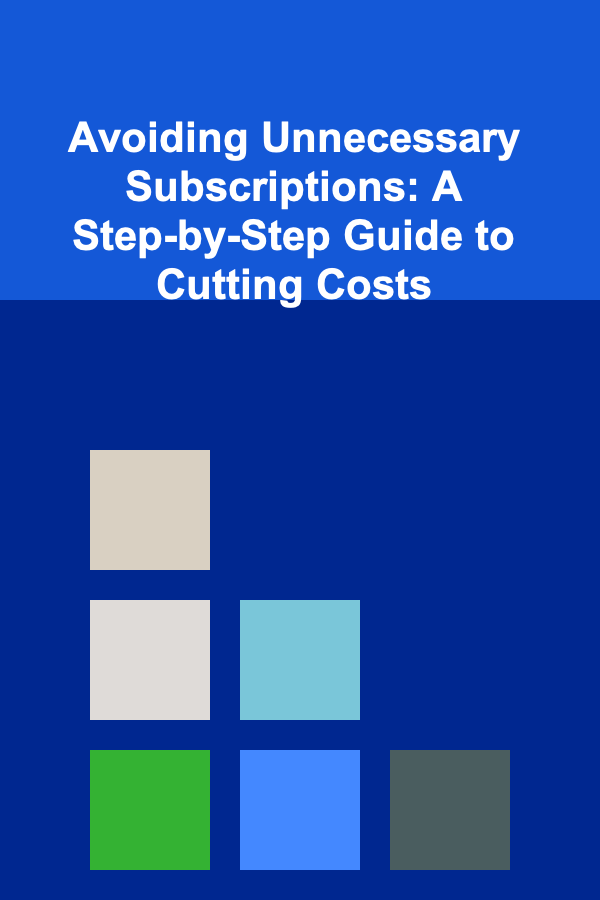
Avoiding Unnecessary Subscriptions: A Step-by-Step Guide to Cutting Costs
ebook include PDF & Audio bundle (Micro Guide)
$12.99$7.99
Limited Time Offer! Order within the next:

In today's digital age, subscriptions have become an integral part of our lives. Whether it's streaming services, apps, magazines, or fitness memberships, we often find ourselves signing up for various subscription-based services. While these services may be convenient and offer value, they can also accumulate quickly, leading to a significant dent in our monthly budget. Many people unknowingly keep subscriptions they no longer use or need, causing unnecessary financial strain.
This actionable guide will walk you through a systematic approach to identifying, evaluating, and cutting unnecessary subscriptions from your life, ultimately saving you money and giving you a clearer, more intentional approach to your spending.
Audit Your Current Subscriptions
The first step in cutting unnecessary subscriptions is to know exactly what you're paying for. Subscriptions are often hidden costs that we don't regularly check, making it easy for them to slip through the cracks of our finances.
Steps for Subscription Audit:
- Check your bank statements: Go through your credit card and bank statements from the past 3-6 months. Look for recurring charges and note down all subscriptions, including streaming services, digital magazines, online tools, and even physical product subscriptions (e.g., meal delivery services).
- Use subscription tracking apps : Several apps and tools help track your subscriptions, such as Truebill , Trim , or Bobby. These apps scan your bank accounts and credit cards to help you identify recurring payments.
- List all active subscriptions: Create a list of all subscriptions you are paying for, including the service name, cost, renewal frequency (e.g., monthly, annually), and the renewal dates.
This audit is crucial because it's easy to forget about subscriptions once they're automatically renewed. By identifying all your active subscriptions, you'll have a clearer picture of your current spending habits.
Evaluate the Value of Each Subscription
Once you have a comprehensive list of your subscriptions, it's time to assess whether each one is providing value. Just because you're paying for a service doesn't mean you're getting your money's worth. Take time to think critically about each subscription's utility and its relevance to your lifestyle.
Key Questions to Ask:
- Do I use it regularly? A service that you use daily or weekly justifies the cost, but if you rarely access it, it might be worth reconsidering.
- Has my use decreased? Sometimes, we sign up for services with good intentions (e.g., gym memberships), but over time, we stop using them.
- Is there a cheaper or better alternative? For each service, explore if there are more affordable alternatives that can meet your needs or even if free options could suffice.
- Am I paying for features I don't need? Some subscription services have tiers with features you might not be using. Consider downgrading to a cheaper plan.
Example:
You might have a subscription to a music streaming service that costs $10 a month, but you've started using YouTube for music instead. In this case, it makes sense to cancel the paid subscription, as you're not maximizing its value.
Cancel Subscriptions That Aren't Adding Value
After evaluating your subscriptions, it's time to make tough decisions and cancel those that are no longer beneficial. While it can feel challenging to let go of certain services, keeping them is essentially an ongoing waste of money. Canceling unnecessary subscriptions can feel liberating and provide instant financial relief.
How to Cancel:
- Cancel through the service provider: Most subscription services allow you to cancel directly through their website or app. Look for an option in your account settings or billing section.
- Set a reminder for trial periods: If you're trying a service with a free trial, set a reminder a few days before the trial expires so you can cancel it if you decide it's not worth the subscription cost.
- Automate cancellations if needed: Services like Truebill or Trim can help you cancel subscriptions directly or send you reminders before renewals.
Pro Tip:
If a company makes it difficult to cancel, don't be afraid to call customer service. Many companies are willing to cancel your subscription over the phone if they realize you're seriously considering leaving.
Evaluate Your Subscription Needs on a Regular Basis
Your needs and habits can change over time, so it's essential to periodically evaluate your subscriptions to ensure they still align with your lifestyle and financial goals. What was once a must-have subscription may become irrelevant or unnecessary as your priorities evolve.
Set Regular Reviews:
- Quarterly reviews: Set aside time every few months (e.g., quarterly) to review your subscriptions. During these reviews, ask yourself if any new subscriptions have crept in or if any old ones are no longer needed.
- Use reminders: Set a reminder in your calendar for subscription review dates, so you don't forget to reassess your recurring costs.
By regularly evaluating your subscriptions, you'll avoid accumulating services that drain your budget.
Switch to Pay-as-You-Go or One-Time Purchases
For many subscription services, paying on a recurring basis might not always be the best option. Some services offer the same value if you opt for a one-time purchase or pay-as-you-go model instead of a subscription.
Alternatives to Subscriptions:
- Streaming services: Instead of subscribing to multiple streaming platforms, consider using pay-per-view options for movies or shows you only watch occasionally. This approach helps you avoid paying for multiple streaming services you rarely use.
- Fitness memberships: If you don't work out regularly enough to justify a monthly gym fee, consider switching to pay-per-class options or using free fitness apps or online workout videos.
- Cloud storage: Instead of a recurring cloud storage subscription, opt for a one-time purchase of an external hard drive or USB stick, especially if you don't need constant access to cloud services.
By switching to alternatives like these, you'll only pay for what you need when you need it.
Consider Sharing Subscriptions
Many subscription services, especially streaming platforms, allow multiple users to share one account. This can drastically reduce your costs by splitting the subscription fees with family or friends.
Ways to Share Subscriptions:
- Streaming services: Netflix, Spotify, Hulu, and other platforms allow family plans where multiple users can share a single subscription.
- Software subscriptions: Some software providers, such as Adobe or Microsoft, offer discounted family or team plans that allow multiple users to access the software under one subscription.
- Meal delivery services: If you use meal subscription boxes, consider sharing them with a friend or family member to reduce the per-person cost.
Ensure that everyone involved is aware of the terms and rules regarding shared accounts to avoid violating any agreements.
Take Advantage of Free Trials
Free trials are often a double-edged sword; they offer access to premium services at no cost for a limited time, but many people forget to cancel them before they turn into paid subscriptions. However, if used correctly, free trials can be a great way to test out a service without making a long-term commitment.
Tips for Managing Free Trials:
- Set reminders: As soon as you sign up for a free trial, set a calendar reminder a few days before the trial expires so you can cancel if it doesn't meet your needs.
- Keep track of your trials: Maintain a list of all free trials you've signed up for, including the expiration dates, so you don't forget to cancel.
- Be mindful of automatic renewals: Ensure you read the fine print regarding what happens after the free trial period ends. Some services automatically charge you if you forget to cancel.
Conclusion
Cutting unnecessary subscriptions is a powerful way to reduce your expenses and regain control of your finances. By auditing your subscriptions, evaluating their value, and taking proactive steps to cancel those you no longer need, you can save money and create a more intentional spending plan. Regularly reviewing your subscriptions and considering alternatives, such as sharing accounts or opting for pay-as-you-go options, will help you keep your costs down and ensure that your spending aligns with your lifestyle and financial goals.
By following these steps, you'll enjoy greater financial freedom and peace of mind, knowing that your money is being spent on things that truly matter.
Reading More From Our Other Websites
- [Home Staging 101] How to Stage a Bathroom to Make a Lasting Impression
- [Personal Financial Planning 101] How to Reduce Expenses Without Sacrificing Quality of Life
- [Home Cleaning 101] How to Deep Clean Your Refrigerator in 10 Easy Steps
- [Home Maintenance 101] How to Understand Appliance Energy Ratings
- [Home Cleaning 101] How to Clean with Vinegar: Eco-Friendly Solutions for a Clean Home
- [Home Family Activity 101] How to Build a DIY Backyard Theater for Unforgettable Family Movie Nights
- [Personal Care Tips 101] How to Choose a Hair Mask to Manage Hair Thinning
- [Rock Climbing Tip 101] How to Adapt Yoga Flows for the Flexibility Needed in Slab Climbing
- [Ziplining Tip 101] How to Choose Eco‑Friendly Clothing Materials for Comfortable Ziplining
- [Home Holiday Decoration 101] How to Create a Winter Wonderland Living Room for the Holidays

How to Screen Tenants for Your Rental Property Effectively
Read More
How to Take Care of Your Home's Insulation for Energy Savings
Read More
The Clinical Research Coordinator's Playbook: Streamlining Processes in Medical Research
Read More
How to Understand What Your Personal Data Is
Read More
How to Understand and Use Healthy Spices
Read More
10 Tips for Sales Manager Time Management & Productivity
Read MoreOther Products

How to Screen Tenants for Your Rental Property Effectively
Read More
How to Take Care of Your Home's Insulation for Energy Savings
Read More
The Clinical Research Coordinator's Playbook: Streamlining Processes in Medical Research
Read More
How to Understand What Your Personal Data Is
Read More
How to Understand and Use Healthy Spices
Read More